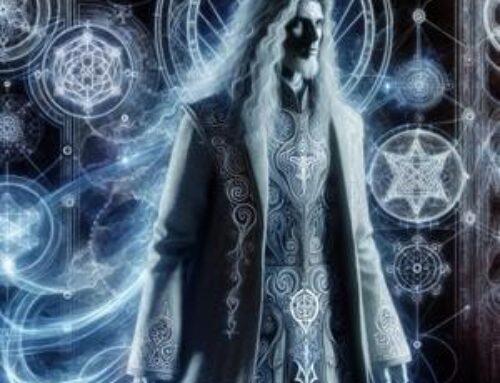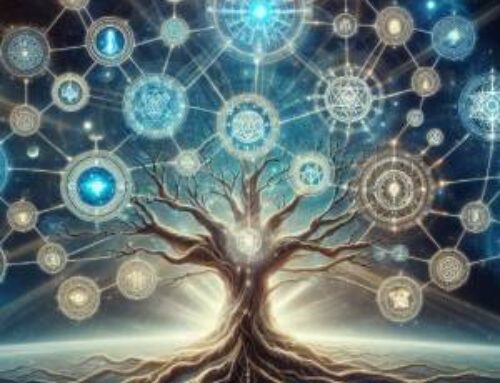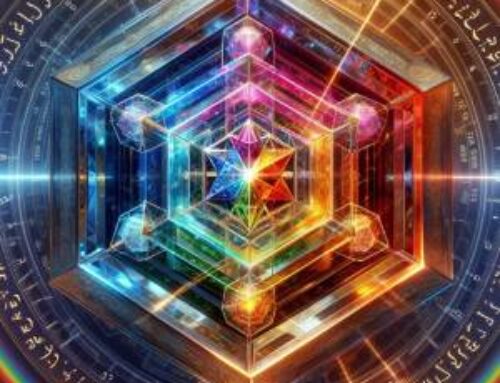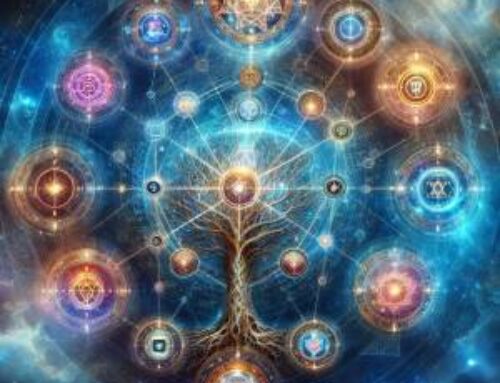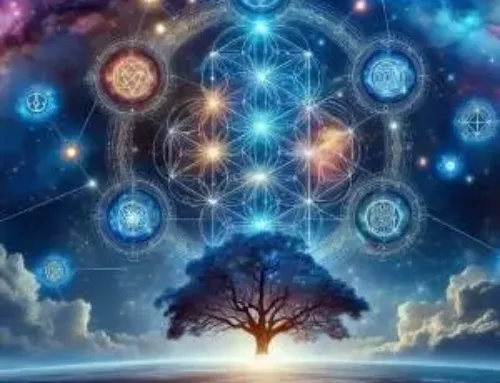Contents
- 1 Introduction to God in Kabbalah
- 2 The Sefirot: Divine Emanations of God in Kabbalah
- 3 Ein Sof: The Infinite Nature of God
- 4 The Role of Humanity in the Divine Structure
- 5 Practical Kabbalah: Invoking the Divine Names
- 6 Conclusion
- 7 FAQ – God in Kabbalah
- 7.1 1. What is the central concept of God in Kabbalah?
- 7.2 2. How do the Sefirot function within Kabbalistic teachings?
- 7.3 3. What is the role of humanity in Kabbalah?
- 7.4 4. How is initiation understood in Kabbalah and its connection to the Sefirot?
- 7.5 5. Where can I study Kabbalah to gain a deeper understanding of these concepts?
- 8 References
Introduction to God in Kabbalah
In the arcane domains of spiritual mysticism, Kabbalah articulates a sublime vision of the Divine that sharply contrasts with conventional theistic images. Here, the Divine is not just an august sovereign distant from the world but a profound, pervasive lattice of divine energies that molds the universe’s essence. This delve into Kabbalistic philosophy reveals not an aloof, singular deity, but a vibrant, interconnected divine presence, animating every facet of the cosmos.
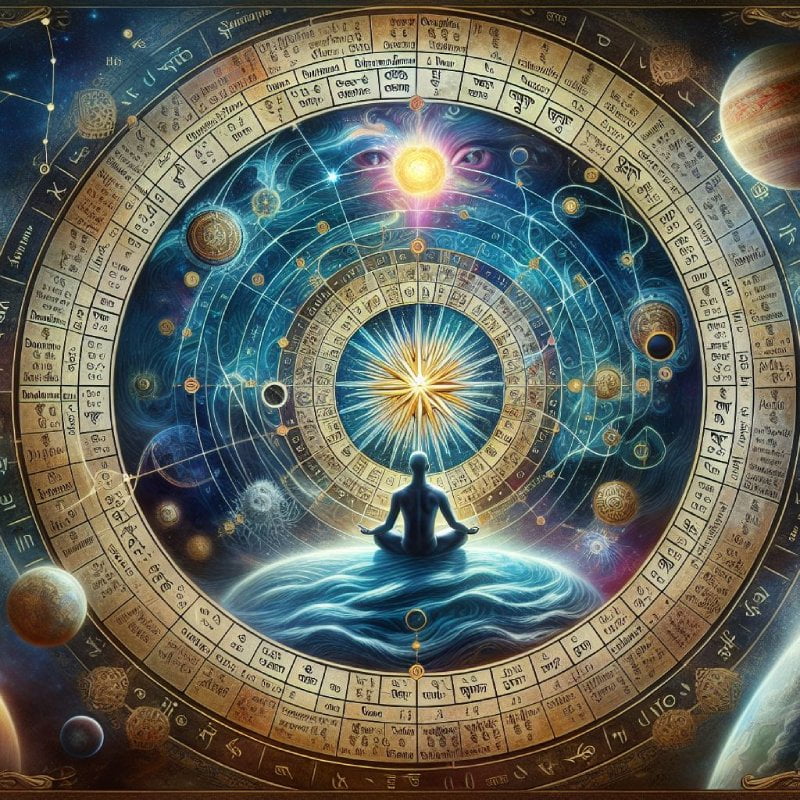
At the heart of this perception lies the concept of the Ein Sof (Ain Soph) — the Infinite. Stripped of human-like traits, the Ein Sof is the endless origin, the wellspring of all being, from whence all creation emanates. In the mystical architecture of the Divine in Kabbalah, the Sefirot act as essential channels bridging the celestial with the terrestrial. These ten emanations, through which this source manifests, interlace the physical and metaphysical, crafting a nexus between humanity and the sacred.
The Divine in Kabbalah is perceived not as a detached sovereign but as the Ein Sof, an infinite essence suffusing all that exists. Each channel embodies unique divine forces—from stern justice to generous mercy—reflecting the complex nature of reality. Humanity’s function within this schema is crucial; we are not passive observers but active participants charged with Tikkun Olam, the mending of global harmony and equilibrium.
This initial venture into the nature of “God in Kabbalah” presents more than mere ancient insights; it beckons us to broaden our spiritual vistas, to interact with a universe that is at once an expression of divine intent and a mirror to our own spirits. Through this perspective, Kabbalah does not merely educate; it transforms, compelling us to harmonize our deeds with a grander, universally intertwined plan.
The Sefirot: Divine Emanations of God in Kabbalah
Understanding the Sefirot – Gateways to the Divine
The Sefirot of Kabbalah represent ten foundational aspects through which the divine manifests its essence into the world (1). Each Sefira serves as a prism, refracting the singular divine light into various attributes essential for the multiplicity of existence. The highest Sefira, Keter, or Crown, is seen as the will of God, while the lowest, Malkuth, represents the divine kingdom present within the physical realm. This vertical arrangement forms a ladder of spiritual ascent for seekers, bridging the infinite with the finite.
The Dynamic Flow of Divine Energy
In Kabbalistic philosophy, the Sefirot are interconnected through dynamic channels that create a fluid and living tree of life. This structure is not static; it pulsates with divine currents that circulate energy from the highest echelons down to the earthly realm. Each Sefira filters and tempers this energy, tailored to its unique aspect, ensuring that the divine influx is balanced and appropriate for each level of creation. This system highlights the balance between mercy and severity, guiding individuals on how to align their actions with divine harmony.
The Integration of Sefirot in Daily Life
Kabbalists integrate the wisdom of the Sefirot into daily life by meditating on their divine attributes. For instance, contemplation on Chesed (mercy) or Gevurah (severity) can help individuals balance their emotional responses with wisdom and understanding. Through practical application, the Sefirot transcend their metaphysical origins, becoming tools for personal and spiritual growth. This approach allows adherents to cultivate a life that not only mirrors the divine virtues but also actively contributes to the cosmic repair, or Tikkun Olam, of the world.
Ein Sof: The Infinite Nature of God
The Concept of Ein Sof in Kabbalistic Thought
Ein Sof (Hebrew: AYN SVPh), or the Boundless, is the ultimate expression of the divine in Kabbalah. It transcends all categories and limitations, representing an absolute infinity that neither exists in the known universe nor is comprehensible to the human mind. This concept pushes spiritual seekers to expand their understanding of existence beyond the visible, challenging them to embrace a form of divine reality that is without end or beginning.
Ein Sof and the Creation Process
In Kabbalistic cosmology, Ein Sof is the source of all creation, initiating the emanation process through the Sefirot (2). This act of creation is not viewed as a single event but as an ongoing, dynamic process. The light of Ein Sof contracts, creating a space in which finite and independent beings can exist. This conceptual framework allows Kabbalists to explore the relationship between the infinite and the finite, offering a unique perspective on the nature of reality and the divine intention behind creation.
The study of Ein Sof involves a mystical practice known as “negative theology,” where one approaches the divine by understanding what it is not, rather than what it is. This method is crucial for approaching such an incomprehensible subject, where definitive attributes fall short. Through meditation, study, and ethical living, Kabbalists seek to remove the veils of illusion that obscure the divine presence, progressively drawing closer to a direct encounter with the infinite aspects of God.
The Role of Humanity in the Divine Structure
The Purpose of Humanity in Kabbalistic Cosmology
In Kabbalistic thought, humanity holds a unique place in the divine structure of the universe. Human beings are seen as agents of Tikkun Olam, or ‘repairing the world,’ which entails bringing the physical and spiritual worlds into harmony. This concept underscores the belief that human actions can either contribute to or detract from the divine plan, depending on their alignment with the spiritual laws that govern the universe.
Co-Creators with the Divine
Humans are considered co-creators with God in Kabbalah, tasked with the sacred duty of completing creation. This partnership involves using free will to choose actions that reflect divine attributes, such as compassion, justice, and humility. Each moral and ethical decision made by an individual contributes to the overall sanctity or degradation of the physical world, thereby affecting the Sefirotic balance.
Practical Kabbalah: Invoking the Divine Names
Harnessing Divine Energies through Names
Practical Kabbalah involves the use of divine names and incantations as tools for influencing both spiritual and physical realms. These names, believed to be encoded with the raw energies of creation, allow practitioners to tap into the celestial forces represented by the Sefirot. By invoking these names with specific intentions, Kabbalists seek to manifest real-world changes that align with divine will.
The Sacred Art of Divine Invocation
The practice of invoking divine names is considered a sacred art in Kabbalah, requiring purity of intent and adherence to strict spiritual disciplines. Misuse of these powerful energies can lead to negative repercussions, reflecting the belief that with great power comes great responsibility. Thus, training under a knowledgeable guide is essential for anyone seeking to explore this path.
The Role of Meditation and Visualization
Meditation and visualization are key components of Practical Kabbalah. Practitioners use these techniques to envision the Sefirotic tree, aligning their spiritual bodies with the divine energies it represents. This alignment not only facilitates personal transformation but also enhances one’s ability to perform Tikkun Olam, thereby acting as a bridge between the heavenly and the earthly.
Initiation and the Sefirot
In Kabbalah, initiation is intricately tied to the understanding and experiential engagement with the Sefirot—the dynamic emanations through which the Divine expresses and manifests in the world. This spiritual initiation is not ceremonial but a profound internal process that unfolds as one explores and connects with each Sefira (Sephirah), drawing closer to the divine essence.
Transformation and Tikkun Olam
The journey through the Sefirot is not only about personal enlightenment but also about Tikkun Olam—repairing the world. Each step of initiation empowers the initiate to contribute positively to the world, aligning personal actions with divine will and fostering global transformation.
Conclusion
Exploring God in Kabbalah reveals a dynamic, interconnected divine presence, where human actions contribute directly to the cosmic balance. In the profound realm of Kabbalah, initiation through the Sefirot offers not merely a path to personal enlightenment but a transformative journey that aligns the initiate with the divine cosmos. This spiritual ascent through the Tree of Life—from Malkuth’s earthly grounding to Keter’s sublime crown—provides a blueprint for holistic development, integrating the physical, emotional, and spiritual dimensions of life.
This journey of initiation does more than unveil the mysteries of divine emanations; it actively involves the initiate in the process of Tikkun Olam, or the restoration of the world’s harmony. Each step on this path enhances the individual’s ability to manifest the virtues of the Sefirot in everyday life, thus contributing to the universal balance and forwarding the collective spiritual evolution.
Transform Knowledge into Wisdom
To delve deeper into these esoteric teachings, consider joining the Hermetic Academy. Here, you can explore Kabbalistic wisdom in depth, and learn practical applications that can further your spiritual journey.
The spiritual journey is a lifelong process that involves exploring one’s inner self and a larger cosmic consciousness, often leading to transformational experiences and assisting others in healing processes (3).
FAQ – God in Kabbalah
1. What is the central concept of God in Kabbalah?
A: In Kabbalah, God is perceived as transcending conventional theistic depictions and is known as Ein Sof (The Boundless), an inexhaustible wellspring from which all creation emerges. This vision casts God not merely as a sovereign but as a dynamic, interconnected divine force influencing every dimension of the cosmos.
2. How do the Sefirot function within Kabbalistic teachings?
A: The Sefirot are ten divine emanations through which the Ein Sof expresses itself, each manifesting specific divine energies such as justice or mercy. These emanations act as conduits, intertwining the physical and spiritual realms, and constructing an essential conduit between humanity and the divine.
3. What is the role of humanity in Kabbalah?
A: Within the cosmic schema of Kabbalah, humans are not merely spectators but pivotal contributors to Tikkun Olam, the mending of universal harmony. Through actions in harmony with divine attributes, humans partake in a celestial partnership, striving to equilibrate spiritual ordinances and corporeal reality.
4. How is initiation understood in Kabbalah and its connection to the Sefirot?
A: Initiation in Kabbalah signifies a personal and spiritual enlightenment that enhances one’s rapport with the Sefirot, the divine channels. This experience transcends mere ritualistic acts, facilitating an elevated traversal through the Sefirot from Malkuth to Keter, fostering an all-encompassing assimilation of sacred knowledge.
5. Where can I study Kabbalah to gain a deeper understanding of these concepts?
A: The Hermetic Academy stands as an exemplary institution for a thorough exploration of Kabbalah. Offering curricula on the Sefirot, Ein Sof, and practical applications, the academy’s seasoned mentors provide a systematic educational experience that profoundly enriches one’s spiritual endeavors and comprehension.
References
(1) Mathers, S. L. M. (1887). The Kabbalah Unveiled. London: George Redway.
(2) Rubenstein, E. (2020). The Tree of Life: The Kabbalah of Immortality. Hermetic World, Paphos.
(3) Keegan, L. (1991). Spiritual Journeying. Journal of Holistic Nursing, 9, 14 – 3. https://doi.org/10.1177/089801019100900103.

